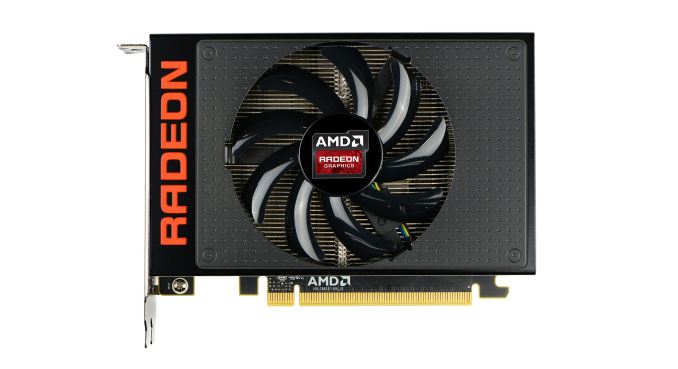AMD Cuts Price of Radeon R9 Nano to $499
by Ryan Smith on January 11, 2016 7:35 AM EST
Word comes from AMD via a press release this morning that they are giving the Radeon R9 Nano a price cut. AMD’s diminutive flagship, which launched in September 2015 at $649, is now the first Fiji card to get an official price cut, with AMD lowering the MSRP to $499 effective immediately.
The third card based on AMD’s flagship Fiji GPU, the Radeon R9 Nano was in a sense a culmination of AMD’s design goals for Fiji. Seeking to take full advantage of the compact packaging afforded by the use of High Bandwidth Memory, AMD packed a fully enabled Fiji into a Mini-ITX sized video card designed especially for small form factor systems. The resulting card was neither a performance flagship card like the Fury X nor a clear second-tier card like the regular Fury, but rather a third card that occupied its own niche within the PC market. This coupled with its unique power binning requirements led to it being launched as a micro-sized alternative to the full Fury X at the same $649 MSRP.
This marks the first instance of a significant price cut for a Fiji card – since their respective launches we’ve seen all three cards drift lower by only $50 or so – and that the card receiving a price drop is AMD’s most recently launched Fiji card is a bit surprising. From a price/performance perspective the Nano was essentially priced as a luxury card, with AMD banking on being able to charge a premium for its improved power efficiency and small size. Today’s price drop essentially puts an end to that, especially since the two Fury cards are not receiving a price cut of their own. With that said, the Nano’s power requirements call for what is arguably the best Fiji chip bin, so that adds another wrinkle to the entire situation.
More interesting perhaps is where this puts the R9 Fury (vanilla), which can already be found for as low at $499. The R9 Fury is only a few percent faster than the R9 Nano and noticeably more power hungry as well, so if the R9 Fury remains at $499 then it's hard to imagine the R9 Nano not being disruptive to R9 Fury sales.
Finally, it’s also worth noting that this comes just days after NVIDIA’s most recent game bundle announcement. Although not specifically addressed by AMD, this may be their response to that bundle in order to shore up their lineup against the similarly-priced GTX 980. Especially since this now places AMD's most power efficient card against NVIDIA's most efficient card, offering about 5% better performance for 5% higher power consumption.
| Winter 2016 GPU Pricing Comparison | |||||
| AMD | Price | NVIDIA | |||
| $629 | GeForce GTX 980 Ti | ||||
| Radeon R9 Fury X | $599 | ||||
| Radeon R9 Fury Radeon R9 Nano |
$499 | ||||
| $479 | GeForce GTX 980 | ||||
| Radeon R9 390X | $379 | ||||
| Radeon R9 390 | $299 | GeForce GTX 970 | |||










74 Comments
View All Comments
baobrain - Monday, January 11, 2016 - link
How would this affect retail prices? Would they go down or is this just the MSRP?nathanddrews - Monday, January 11, 2016 - link
Retail price drops usually follow MSRP drops. Custom models/bundles will still be priced higher than $499.ToTTenTranz - Monday, January 11, 2016 - link
AFAIK, AMD doesn't allow for custom models of the Nano or the Fury X, since the "package" includes their own cooling and power regulation units.The only Fiji that allows customization is the Fury.
Flunk - Monday, January 11, 2016 - link
That's because the Nano and Fury X are essentially the same chip and the cooling and frequencies are the only differentiating factor. A custom Nano could be clocked up to compete with or beat the Fury X.fnZx - Monday, January 11, 2016 - link
Not quite the same, and not likely a custom Nano could tie or beat the Fury X. Here's why:I think it's safe to assume the highest ASIC quality Fiji chips are picked by AMD, and destined for the Nano. Given the throttling/temperature concerns the limited air-cooling can provide to that form factor, AMD would want to reach those target clocks on the Nano with the least amount of voltage possible.
Whereas with an included AIO loop, and a stated goal of being a great overclocker (even if it's actually not), AMD would be dropping lower ASIC quality chips into the Fury X to give it more headroom.
Jm09 - Tuesday, January 12, 2016 - link
was it actually stated they dont intend the nano to OC well? im not doubting you i just havent seen it. I might actually look into getting a pair of these for a custom loop because the OC results are insane when watercooled. still pascal is such a tease, so close yet so far.nathanddrews - Monday, January 11, 2016 - link
Well then, I guess that answers that question.Large Marge - Wednesday, January 13, 2016 - link
Wrong! Asus White Nano uses a custom board & power supply !Colin1497 - Monday, January 11, 2016 - link
Not terribly surprising considering that, while maybe the most interesting card, it was also the one maybe reaching for a niche. It was better than the competition and priced that way, but the question was whether the market would justify the price, and it looks like it didn't.This is a much more interesting card at this price, I'd guess.
medi03 - Thursday, January 14, 2016 - link
Beats 980 in most games.